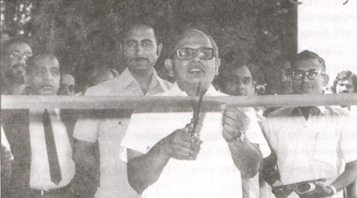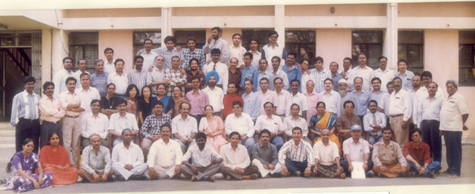4. THE WORK OF TWO DECADES
4. 5. Work on the training front
From the outset, the NTI gave priority not only to the training of DTC key personnel but the quality, duration and content of the training activities were constantly reviewed and upgraded. During the two decades, there had been a steady growth in the area covered and the number of trained personnel available for NTP in the country. By 1996, 72 regular training courses for DTP key personnel had been conducted. However, the NTI was not satisfied because the NTP was functioning below expectations. It had not shown the steady progress warranted by the ever increasing burden of disease to fight it effectively.
 Dr B Shankaran, DGHS with Dr A Banerji Director (Standing to his left) inaugurating the new training block on 16.9.1980 |
The reasons were apparent. Despite the fact that the NTI tried to enthuse the state governments, there has been a steady decline in the number of trainees being sent, for all the categories. Sufficient importance was not given to sending appropriately qualified personnel for training or, effectively utilising the benefits of training by keeping the trained ones in the TB field. While some states stopped sending trainees altogether, some others were lukewarm in their response. There was also the proverbial budgetary restriction. This affected the drug supply and consequently the programme.
In order to become more accessible to those who are quite at a distance from Bangalore, an unusual step was taken during 1990-91 to hold the Group Educational Activity (GEA) at different places of India, at convenient locations, so as to cover different states. For e.g., they were held at Chinsura and Hoogly (West Bengal); Aurangabad (Maharashtra), Chindwara (Madhya Pradesh), Agarthala (Tripura), Ahmedabad (Gujarat), Hyderabad (Andhra Pradesh), and Ajmer (Rajasthan). The GEA was a platform for information dissemination. The GEAs received support from the respective governments and there was an appropriate response in terms of the number of trained, untrained personnel. These included senior administrators also111.
From early days, NTI began to organise two months to six months training programmes for young scholars in research methodology. The NTI developed different kinds of training/orientation/familiarisation strategies for academicians, PGs, researchers, administrators and special groups (Bacteriologists, Epidemiologists). To suit the different needs, it evolved course contents for seminars, workshops and Continuing Medical Education (CME). In 1995-96, 305 medical students from five medical colleges of south India visited the NTI for the briefing courses. Fifteen MOs and one para medical were briefed in TB control and other specified areas that year under the WHO fellowship. Occasionally, medical students came from USA, Canada and England for their tropical posting.
The NTI had also acknowledged the need to decentralise the training of DTC key personnel and transfer the responsibilities to the STCs so that each state became more independent. One of the main purposes was to make the state governments realise their own responsibilities to set up an effective STC to run the TB programme of the state. Thus, the NTI replaced the regular training course into the Trainers Training Programme of eight weeks duration; the first one was started on 8th January ‘96 from which participants of nine states benefited. It was also attended by two MOs from Myanmar and one para medical from Nepal. It was expected that the well equipped STCs will start the training courses for the DTC key personnel. In actuality none of the STCs could do so. Eventually NTI resumed the regular training courses after an interval of two years as the gap between trained and untrained staff started widening at DTCs.
 81st Training Course, January - March 1999 |
|
The fact that the NTP has not succeeded so far
in fulfilling the difficult mission, does not justify adopting easy
postures that betray an escapist tendency. For e.g., the DTOs must
realise that a very good district clinic under the DTP can never
substitute a set of well distributed and well implemented PHIs functioning
under adequate supervision. Moreover, a good physician at a central
clinic is less of a necessity than a good organiser and supervisor
of the programme activities in the context of the DTP. Similarly,
research studies revealed that the urban aspects of the problem
is of much lower priority in comparison with the rural ones. Though
a lot has changed since the NTI started its researches and recommended
a programme, the basic problem continues to remain unaltered. It
is, however, necessary to take care of both kinds of reactions mentioned
above: the one of resignation and the other of misutilisation of
energy and material resources. |